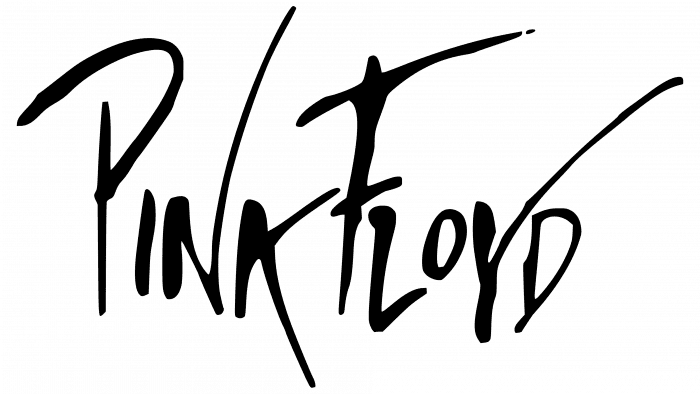Creativity, unique and unlike other bands, is encoded in the emblem. The idea of completeness and self-sufficiency is embedded in the Pink Floyd logo. The band’s sign is like a ship cutting through the darkness, just like the words of their songs point the way to the light.
Pink Floyd: Brand overview
| Founded: | 1965–1994, 2005, 2007, 2013–2014, 2022–present |
| Founder: | Syd Barrett, Nick Mason, Roger Waters, Richard Wright |
| Headquarters: | London, England |
| Website: | pinkfloyd.com |
Meaning and History
Pink Floyd owns many graphic symbols because, for the band members, designing emblems was once as important an aspect of creativity as making music. However, until 1985 they did not have a specific logo. Pictures and test elements from the covers of new albums, which were regularly published since 1967, were used as temporary signs. Recently, musicians have often used one of the recognizable symbols: a multicolored rainbow strip with a zigzag line. Above it is the name of the band in Rockwell script.
What is Pink Floyd?
This is a British rock legend who became famous for her exquisite shows, philosophical songs, experimental music, and unusual cover designs. The most famous leader of the group was Syd Barrett. Pink Floyd has not existed since 2015.
1967 – 1972
The band’s first emblem was a simple “Pink Floyd” inscription. Word layout, font, style were constantly changing. The name for the rock band was chosen by one of its ideologues – Roger Keith “Syd” Barrett. Without thinking twice, he combined the blues artists’ names Pink Anderson and the Floyd Council.
1973 – 1978
The most memorable image of Pink Floyd was a triangular prism through which a ray passed, refracting and decaying into the entire spectrum of colors. This drawing became the main decoration of The Dark Side of the Moon. Its author is Storm Elvin Thorgerson. The graphic designer took into account the angle of deflection of the light wave from the point of view of physics and paid special attention to contrast: the rainbow colors stand out brightly against the black background.
1979 – 1985
In 1979 there was a new album called The Wall. This moment turned out to be a turning point: the “brick” cover featured the phrase “Pink Floyd,” which eventually became the logo. The inscription was guessed by the handwriting of Gerald Scarfe – the man who made many animations for the group. Subsequently, typographers developed the Floydian typeface based on the logo.
1985 – 2011
In 1985 bassist Roger Waters left the band, leaving guitarist David Gilmour free to act. The new chapter decided that the band needed official emblems, so shortly before the Division Bell compilation was published, it had its monogram symbol, consisting of an uppercase “P” and a lowercase “f.” A little later, a logo was created called The Boatman, in which the “P,” “F,” “D,” and “G” were encrypted.
Pink Floyd: Interesting Facts
Pink Floyd, formed in London in 1965, is a legendary rock band famous for its psychedelic sound, deep lyrics, and extraordinary live shows.
- Formation: The band started with Syd Barrett, Roger Waters, Richard Wright, and Nick Mason. The name “Pink Floyd” combines the names of two blues musicians, Pink Anderson and Floyd Council.
- Syd Barrett’s Influence: Barrett, the band’s first lead vocalist and guitarist, played a key role in shaping their initial sound with his experimental guitar effects. However, due to mental health issues, David Gilmour replaced him in 1968.
- The Dark Side of the Moon: This 1973 album, exploring themes like conflict and mental illness, is one of their biggest successes, staying on the Billboard charts for years.
- Album Art: Their albums, especially “The Dark Side of the Moon” with its prism design, have some of the most iconic covers in rock, created by Storm Thorgerson and Hipgnosis.
- Concept Albums: Known for concept albums, “The Wall” (1979) stands out. It tells the story of a rock star’s isolation and was later adapted into a film.
- Live Performances: Pink Floyd’s shows were known for their complexity, featuring light shows, stage sets, and projections, notably during “The Wall” tour.
- Sound Effects: The band often used unique sound effects and instruments, like the cash register sounds in “Money.”
- Wish You Were Here: The 1975 album includes “Shine On You Crazy Diamond,” a tribute to Syd Barrett, who visited the studio during its recording, looking so different that some band members didn’t recognize him.
- Live 8 Reunion: In 2005, Waters, Gilmour, Mason, and Wright reunited for the Live 8 concert, their last performance before Wright died in 2008.
Pink Floyd remains a pivotal force in progressive rock. It is known for its innovative sound, thoughtful lyrics, and mesmerizing performances, which have influenced many and left a lasting legacy in music.
Font and Colors
Strict frames do not limit the corporate identity of Pink Floyd: the band members approached this issue creatively. They have accumulated many iconic logos, such as the triangular prism refracted beam or The Boatman monogram.
Each album had its original design, so the appearance of the inscriptions was constantly changing. For example, the cover of The Wall uses a thin handwritten typeface with sweeping letters – a sample of Gerald Scarfe’s handwriting.
The classic palette of Pink Floyd is a contrasting combination of black, white, and all the colors of the rainbow. It became famous right after the release of The Dark Side of the Moon in 1973.
FAQ
Why did Pink Floyd change their logo?
The group has updated its logo to celebrate the 50th anniversary of its classic album, “The Dark Side of the Moon.”
The new logo included elements from the original album cover, known for its prism and light beam design. Updating their logo was done to create a fresh yet nostalgic look that resonated with long-time fans and attracted new listeners.
The redesign sparked controversy among fans. Some accused the band of being overly “woke,” expressing dissatisfaction with what they saw as an unnecessary and politically motivated change. The backlash showed a divide among supporters, with some embracing the new logo as a fitting tribute and others feeling it strayed too far from the iconic imagery they associated with the brand.
What does Pink Floyd’s symbol mean?
Pink Floyd’s symbol, featured on their album “The Dark Side of the Moon,” is a prism with a light beam passing through it. Storm Thorgerson, who designed several album covers for the band, created this design.
In an interview with Rolling Stone, Thorgerson explained that the light and prism were meant to represent the light show that was a key part of the brand’s concerts. The band was known for their elaborate live performances with stunning visual effects, and the prism symbol captures this aspect of their identity.
The light beam entering the prism and splitting into colors symbolizes the band’s exploration of themes and emotions through their music. The choice of a prism suggests clarity and transformation, reflecting how the band’s music examines different facets of human experience.
The simple and elegant design has had a lasting impact, making it one of the most iconic images in music history.
What is the Pink Floyd triangle?
The Pink Floyd triangle, seen on the cover of “The Dark Side of the Moon,” shows a glass prism dispersing white light into colors. This design has deep meaning and represents key parts of the band’s identity.
The design stands for three main things: the band’s stage lighting, the album’s lyrics, and a request from Richard Wright, the band’s keyboardist, for a “simple and bold” design. The prism and light beam reflect the impressive light shows that were a key part of the brand’s live performances. These shows were known for their stunning visual effects, making the prism a fitting symbol.
The prism connects to the themes in the album’s lyrics. “The Dark Side of the Moon” examines human experiences and emotions like conflict, greed, time, and mental illness. The way white light breaks into colors through the prism mirrors the band’s exploration of these themes.
Wright’s request for a “simple and bold” design is captured perfectly in the triangle and prism image. Its clean lines and strong contrast make it a powerful and memorable symbol. The simplicity of the design adds to its impact, making it one of the most recognizable images in music history.
What does the Pink Floyd logo mean?
The last logo, used before the band’s disbandment, had stylized white letters “P” and “F” in a black circle. The “F” was made of two horizontal lines. This simple design represented the band’s name in a clear and modern way.
The logo’s simplicity showed the brand’s desire for a bold, straightforward visual identity. Using only the initials “P” and “F,” the design remained distinctive and strongly connected to the band’s name. The white letters against a black background created a striking contrast, making the logo easily recognizable.
This minimalistic logo matched the band’s progressive and experimental music style. Their music explored deep themes and emotions; the logo captured this with its simple yet powerful design. The two horizontal lines forming the “F” added a unique touch, setting the logo apart from typical designs. The bold letters and stark contrast reflected their innovative approach to music and visual art. This logo, while simple, carried the weight of the band’s history and influence, making it an enduring symbol of their legacy.
How did Pink Floyd get their logo?
Their album covers inspired each of Pink Floyd’s logos. The most famous example is the prism design from “The Dark Side of the Moon.”
The prism, which refracts light into a spectrum of colors, first appeared on this album cover. Designed by Storm Thorgerson, it represented the band’s elaborate light shows and the themes in the album’s lyrics. The image of the prism breaking light into colors captured the essence of their music and innovative spirit.
The success of “The Dark Side of the Moon” made the prism the brand’s emblem. Its simplicity and symbolism perfectly represented their identity.
Other logos used by the brand drew inspiration from their album art. Each design aimed to capture the style and message of the corresponding album.
What is the symbol on the Pink Floyd album?
The most famous symbol is the triangular prism, which passes light through it. This iconic image is on the cover of their album “The Dark Side of the Moon.” Storm Thorgerson designed the prism, dispersing light into colors, which captures the band’s artistic vision.
The prism represents the band’s elaborate light shows, a key part of their live performances. These shows were known for their stunning visual effects, making the prism a fitting symbol of the brand’s commitment to creating immersive experiences. The light breaking into colors through the prism reflects the themes in the album’s lyrics, which explore complex and cosmic subjects.
“The Dark Side of the Moon” cover blends simplicity and depth. The clear lines of the prism and the vibrant spectrum of colors make the image instantly recognizable. This symbol has become synonymous with the brand, representing its innovative spirit and exploring profound themes through music.
Why did Roger leave Pink Floyd?
Roger Waters left Pink Floyd because of creative differences between Dave Gilmour and the other band members. Waters had a strong vision for the band’s music and direction, which clashed with Gilmour’s ideas and the wishes of the other musicians. This conflict made collaboration difficult.
Waters felt his creative ideas didn’t match the direction the other members wanted. He decided to pursue a solo career to realize his artistic vision fully. He believed his departure would lead to the band’s decline, confident that his contributions were vital to their success.
Waters wanted more control over his music and projects. By going solo, he gained the freedom to explore his ideas without the constraints of band dynamics. This move allowed him to continue his musical career on his terms, marking the end of his time with the brand.










